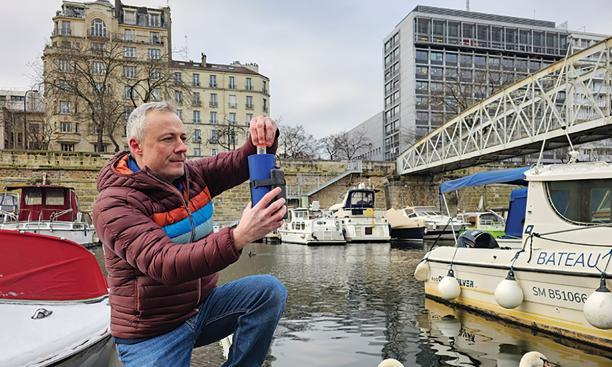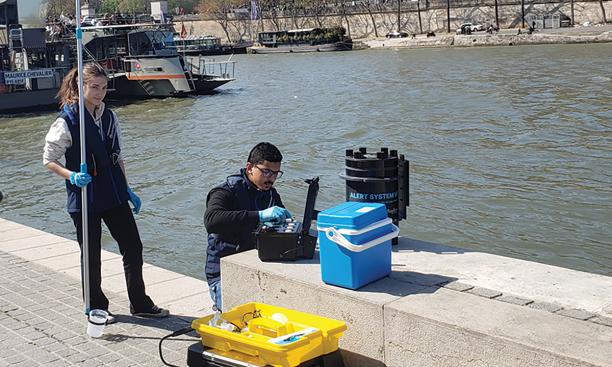
For the past century, swimming in the Seine in Paris has been banned for health safety reasons. But with the Olympics and Paralympics approaching this summer, the city is working to make the iconic river swimmable, first to athletes, and eventually to the public in 2025.
Paris has invested around $1.5 billion in the Seine’s restoration and plans to hold the Games’ opening ceremony on the river. It will be the first time in Olympic history that an opening ceremony takes place outside a stadium, and organizers are expecting 600,000 spectators. The river will also be used for events such as marathon swimming, the triathlon, and para-triathlon.
First, though, officials must finish clean-up efforts.
Enter Dan Angelescu *03, founder and CEO of Fluidion, a water-intelligence company that has developed the technology to sample and measure water quality in real time. For the past seven years, Fluidion has been tracking the concentrations of E. coli and Enterococcus to gauge the general bacterial water quality.
“At any moment, I can get my cell phone and launch a measurement to see what the water quality is here. I can also program the systems to take samples at specific times, such as during a storm event.”
— Dan Angelescu *03
CEO of Fluidion
Using an alert system, which looks like a cage filled with a series of tubes, water is collected and mixed with a substance that measures pollutants with the results being transmitted immediately.
“Paris has a combined sewer system,” Angelescu explains, which comprises sewage and rainwater. Heavy rains overwhelm the wastewater plant, causing the sewage system to overflow into the river and release lush quantities of bacteria. On its own, this is not a concern; these bacteria are relatively harmless.
“In general, it’s other pathogens that always come with them, like the norovirus, or forms of hepatitis and nastier bacteria that can cause serious disease and death that are alarming,” says Angelescu.
But monitoring water quality is just one piece of the project. To decrease the contamination in the Seine, officials are undertaking a slew of measures, starting with installing two disinfection units at wastewater treatment plants and building a subterranean storage basin to manage overflow during significant storms.
This massive concrete reservoir alone will have the capacity to hold up to 50,000 cubic meters of water. In December, the president of the French Olympic Committee said the city is linking 20,000 houses and businesses to the existing sewer system in a way that will prevent waste discharge into the river. Stricter regulations requiring boat owners docked on the Seine to connect to Paris’ wastewater network, to reduce whatever waste they expel, have also been put in place.
Angelescu and his team round out this effort by testing daily and ensuring when the waters are safe for swimmers.

“At any moment, I can get my cell phone and launch a measurement to see what the water quality is here. I can also program the systems to take samples at specific times, such as during a storm event,” says Angelescu.
Fluidion has installed its alert systems at two bridges along the Seine — Pont Alexandre III and Pont Marie — and in the Canal de l’Ourcq, a waterway built to supply Paris with water and a route for freight.
In the case of the Canal de l’Ourcq, specifically, the alert systems monitor the water quality of the Bassin de la Villette, the largest artificial lake in Paris, which links Canal de l’Ourcq to another major waterway, Canal Saint-Martin. La Villette is popular with bathers as well. About 100,000 people swim in the La Villette every year between June and September.
For Angelescu, this project has allowed him to tap into his passions for sustainability and physics.
Born in Bucharest, Romania, Angelescu’s interest in physics was fostered by his parents, who both worked for a state-funded research institute. He became a regular visitor of a physics camp in the Carpathian Mountains — a breeding ground for students participating in the International Physics Olympiad. Angelescu eventually went on to compete for his country also.
He spent a year at the Polytechnic University in Bucharest studying computer science before he received financial aid and a merit scholarship to transfer to the California Institute of Technology.
An undergraduate research fellowship in theoretical physics reignited his interest in the subject. He graduated in 1998 and decided to continue his education through Princeton’s Ph.D. program in physics.
He later worked as a senior research scientist at Schlumberger Limited, an oil field services company, and then as a professor at Université Paris-Est Créteil.
In 2012, he founded Fluidion, which he says he modeled after the Princeton Materials Institute (PMI), the interdisciplinary research center in the field of materials science, where he spent much of his time as a Ph.D. student.
“In the narrow and windowless labs of PMI, different people from different backgrounds came together in a nonhierarchical way and made new science every day in the fields of optics, biology, polymers, quasicrystals, nanolithography,” Angelescu says.
“At the Princeton machine shops, you could learn how to weld aluminum in the morning, build an integrated circuit at lunch, and attend a lecture on superconductivity in the afternoon.” Within his small Fluidion team, the same cross-pollination occurs, he adds.
While the goals of Paris officials are ambitious, Angelescu is up for the challenge. “We want to see people swimming in the Seine,” he says.
